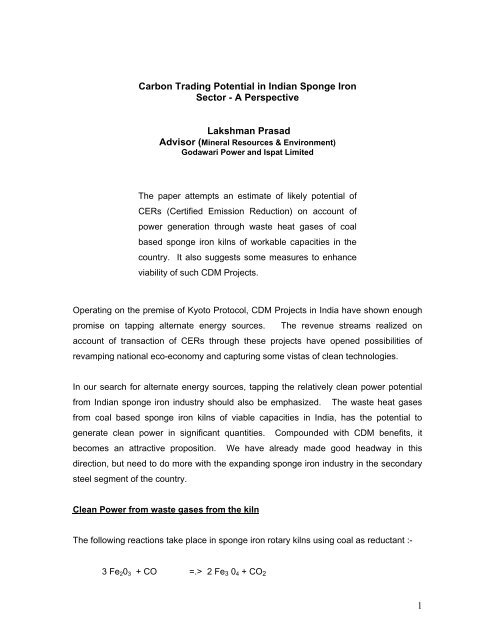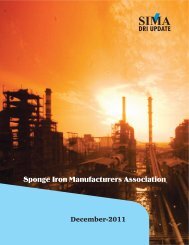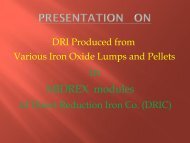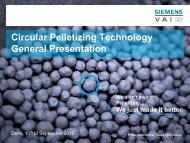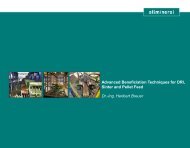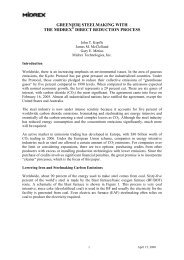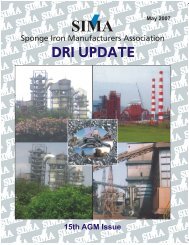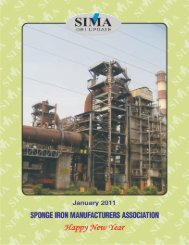Carbon Trading Potential in Indian Sponge Iron Sector - A ...
Carbon Trading Potential in Indian Sponge Iron Sector - A ...
Carbon Trading Potential in Indian Sponge Iron Sector - A ...
Create successful ePaper yourself
Turn your PDF publications into a flip-book with our unique Google optimized e-Paper software.
<strong>Carbon</strong> <strong>Trad<strong>in</strong>g</strong> <strong>Potential</strong> <strong>in</strong> <strong>Indian</strong> <strong>Sponge</strong> <strong>Iron</strong><br />
<strong>Sector</strong> - A Perspective<br />
Lakshman Prasad<br />
Advisor (M<strong>in</strong>eral Resources & Environment)<br />
Godawari Power and Ispat Limited<br />
The paper attempts an estimate of likely potential of<br />
CERs (Certified Emission Reduction) on account of<br />
power generation through waste heat gases of coal<br />
based sponge iron kilns of workable capacities <strong>in</strong> the<br />
country. It also suggests some measures to enhance<br />
viability of such CDM Projects.<br />
Operat<strong>in</strong>g on the premise of Kyoto Protocol, CDM Projects <strong>in</strong> India have shown enough<br />
promise on tapp<strong>in</strong>g alternate energy sources. The revenue streams realized on<br />
account of transaction of CERs through these projects have opened possibilities of<br />
revamp<strong>in</strong>g national eco-economy and captur<strong>in</strong>g some vistas of clean technologies.<br />
In our search for alternate energy sources, tapp<strong>in</strong>g the relatively clean power potential<br />
from <strong>Indian</strong> sponge iron <strong>in</strong>dustry should also be emphasized. The waste heat gases<br />
from coal based sponge iron kilns of viable capacities <strong>in</strong> India, has the potential to<br />
generate clean power <strong>in</strong> significant quantities. Compounded with CDM benefits, it<br />
becomes an attractive proposition. We have already made good headway <strong>in</strong> this<br />
direction, but need to do more with the expand<strong>in</strong>g sponge iron <strong>in</strong>dustry <strong>in</strong> the secondary<br />
steel segment of the country.<br />
Clean Power from waste gases from the kiln<br />
The follow<strong>in</strong>g reactions take place <strong>in</strong> sponge iron rotary kilns us<strong>in</strong>g coal as reductant :-<br />
3 Fe 2 0 3 + CO =.> 2 Fe 3 0 4 + CO 2<br />
1
Fe 3 0 4 + CO => 3 Fe0 + CO 2<br />
Fe0 + CO => Fe + CO 2<br />
The waste gases emanat<strong>in</strong>g from the sponge iron kilns conta<strong>in</strong> substantial amount of<br />
combustibles along with carbon particles, unused CO etc.<br />
It is possible to exploit ga<strong>in</strong>fully such waste heat conta<strong>in</strong>ed <strong>in</strong> flue gases, utilize the same<br />
to produce steam to generate power <strong>in</strong> a suitably designed waste heat recovery system<br />
(WHRS).<br />
In terms of Kyoto Protocol, such waste heat recovery systems, as a clean technology<br />
options, fulfil the criteria of CDM Projects, primarily on account of the follow<strong>in</strong>g features<br />
of additionality :-<br />
i) as compared to a conventional coal based power generation project, WHRS causes<br />
reduced emission of green house gases<br />
ii) the system contributes to <strong>in</strong>dustrial energy efficiency as an attendant benefit<br />
iii) it conserves energy resources, and<br />
iv) it replaces an equivalent amount of electricity from the usual carbon <strong>in</strong>tensive power<br />
grid<br />
An assessment of clean power potential and CDM benefits<br />
Coal based sponge iron plants collectively registered a production of about 11 million<br />
tonnes dur<strong>in</strong>g the year 2006-07. Dur<strong>in</strong>g the current year i.e. 2007-08, the production is<br />
on an upward trend as borne out by the fact that <strong>in</strong> five months period between April –<br />
Aug’07 the recorded production was 5.36 million tonnes.<br />
While the small capacity plants may be constra<strong>in</strong>ed due to scale of economy to produce<br />
power through waste heat recovery systems, the plants hav<strong>in</strong>g capacity of 60,000<br />
tonnes per annum and above i.e, those employ<strong>in</strong>g at least a kiln of 200 TPD or two kilns<br />
of 100 TPD each can viably operate WHRB System. Further the plants operat<strong>in</strong>g at<br />
least one kiln of 350 TPD are expected to be better placed to realize CDM benefits.<br />
2
There are about 90 such feasible plants whose CDM potential can be tapped. While<br />
more than 20 such projects have been registered by the CDM Board of UNFCCC as of<br />
end Oct’07, there have been only eleven issuances of Certified Emission Reduction<br />
(CERs) through n<strong>in</strong>e plants (Godawari Power and Ispat Limited and Shri Bajrang WHR<br />
CDM Project, each be<strong>in</strong>g credited with two issuances). Table-I furnishes the details of<br />
such issuances.<br />
Table –I<br />
Details of CERs * Issued <strong>in</strong> respect of <strong>Indian</strong> Companies <strong>in</strong> <strong>Sponge</strong> <strong>Iron</strong> <strong>Sector</strong> for<br />
WHRB Projects as of Oct’07<br />
S.No. Project Developer Date of Issuance CERs Issued Verified Period<br />
1 Godawari Power and 04 Aug 2006 66,536 01 Sept 2002 –<br />
Ispat Limited<br />
31 Dec 2005<br />
2 Monnet Ispat Limited 06 Sept 2006 1,11,570 01 Jan 2005 –<br />
31 Mar 2006<br />
3 Tata <strong>Sponge</strong> <strong>Iron</strong> Limited 27 Dec 2006 1,06,463 01 Jan 2002 –<br />
31 Mar 2006<br />
22 Jan 2007 74,674 01 Sep 2005 –<br />
31 Aug 2006<br />
4 Shri Bajrang Power &<br />
Ispat Limited<br />
5 Orissa <strong>Sponge</strong> <strong>Iron</strong> Ltd. 02 April 2007 1,25,002 01 July 2001 –<br />
31 Jan 2006<br />
6 Usha Mart<strong>in</strong> Limited 03 April 2007 60,989 01 Dec 2004 –<br />
30 Nov 2006<br />
7 Electro Steel Cast<strong>in</strong>gs 11 June 2007 41,081 ** 01 April 2006 –<br />
31 Jan 2007<br />
8 Shree Nakoda Ispat 27 June 2007 23,368 01 Dec 2005 –<br />
Limited<br />
31 Dec 2006<br />
9 Godawari Power and 02 July 2007 18,607 01 Jan 2006 –<br />
Ispat Limited<br />
31 Dec 2006<br />
10 Vandana Global Limited 26 Sept 2007 31,541 01 April 2005 –<br />
31 Oct 2006<br />
11 Shri Bajrang WHRB 20 Oct 2007 66,885 01 Sept 2006 –<br />
CDM Project<br />
31 May 2007<br />
Total CERs Issued 7,26,716<br />
* a unit CER represents one tonne of CO 2<br />
** <strong>in</strong>cludes waste gases of coke oven batteries and sponge iron kilns<br />
In the overall assessment, tak<strong>in</strong>g a production of 7.7 million tonnes of sponge iron (70%<br />
of actual production dur<strong>in</strong>g the year 2006-07 through viable CDM projects), there is a<br />
potential of produc<strong>in</strong>g about 500 MW power through WHRS with an annual carbon credit<br />
of 1.50 million CERs. Such a projection takes <strong>in</strong>to consideration the follow<strong>in</strong>g<br />
conservative assumptions :-<br />
3
(i) waste gases from a 200 TPD kiln can produce 4MW power<br />
(ii) 1 MW power, on an average, can attract 3000 CERs annually<br />
By the year 2011-12, with the anticipated doubl<strong>in</strong>g of production of sponge iron through<br />
coal based kilns, power generation and correspond<strong>in</strong>g CERs would also be doubled to<br />
realize a credit of about 3 million CERs annually.<br />
Tak<strong>in</strong>g a case of some realistic recent transactions of CERs at 13.75 Euro per unit, there<br />
is bus<strong>in</strong>ess volume of 41 million Euros annually or about 2250 million rupees per year.<br />
Improv<strong>in</strong>g viability of WHRS<br />
In view of such promise of bus<strong>in</strong>ess, there is a strong case to enhance viability of related<br />
projects for better realization compounded with harness<strong>in</strong>g its full potential. Some of the<br />
suggested measures could be :-<br />
(i) earmark<strong>in</strong>g and allocat<strong>in</strong>g non-cok<strong>in</strong>g coal blocks hav<strong>in</strong>g coal of high ash fusion<br />
temperature and high reactivity exclusively for sponge iron sector. Such coals are better<br />
suited to manufactur<strong>in</strong>g of sponge iron.<br />
ii) allocat<strong>in</strong>g iron ore m<strong>in</strong>es to sponge iron manufacturers to ensure availability of<br />
consistent quality of high grade iron ore feed to kilns. This will lead to higher degree of<br />
metallisation and reduced accretion <strong>in</strong> the kilns with less downtime and hence higher<br />
plant availability.<br />
(iii) permitt<strong>in</strong>g open access and <strong>in</strong>ter-state wheel<strong>in</strong>g of power from sponge iron sector at<br />
a reasonable tariff with no h<strong>in</strong>drance.<br />
While on the subject of wheel<strong>in</strong>g power, it is estimated that a waste heat recovery<br />
system based on 350 TPD kiln can generate about 7 MW, out of which 1.5 MW can be<br />
used for captive consumption <strong>in</strong> sponge iron mak<strong>in</strong>g <strong>in</strong> stand-alone sponge iron plants<br />
and a surplus of 5.5 MW can be exported to the grid for trad<strong>in</strong>g. The sponge iron units<br />
graduat<strong>in</strong>g to m<strong>in</strong>i steel plants through forward <strong>in</strong>tegration by employ<strong>in</strong>g <strong>in</strong>duction<br />
furnaces, electric arc furnaces or similar adjuncts would require more power for captive<br />
consumption. Such <strong>in</strong>tegrated plants can use the surplus power cost effectively with self<br />
reliance.<br />
(iv) network<strong>in</strong>g of carbon trad<strong>in</strong>g bus<strong>in</strong>ess through carbon exchanges spread over<br />
strategic locations.<br />
4


